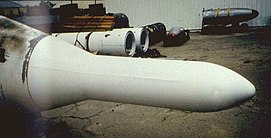W47

TheW47was an Americanthermonuclear warheadused on thePolaris A-1sub-launchedballistic missilesystem. Various models were in service from 1960 through the end of 1974. The warhead was developed by theLawrence Radiation Laboratorybetween 1957 and 1960.[1]
The W47 was 18 in (460 mm) in diameter and 47 in (1,200 mm) long, and weighed 720 lb (330 kg) in the Y1 model and 733 lb (332 kg) in the Y2 model. The Y1 model had design yield of 600kilotonsand the Y2 model had a doubled design yield of 1.2megatons. [2]The W47 was the first warhead with a new, miniaturizedpit.[3]The aerodynamic flare[clarification needed]at the base provided stability of orientation during descent. Two small rocket motors were used to spin the warhead for better stability and symmetry during reentry.
Design
[edit]Declassified British documents indicate that the W47 contained 2.5 kilograms (5.5 lb) ofplutonium,60 kilograms (130 lb) ofuranium,36 kilograms (79 lb) oflithium deuterideand 4 grams (0.14 oz) oftritium.[4]
Live fire testing
[edit]
The W47 is the only USICBMorSLBMwarhead to have beenlive firedin an atmospheric missile and warhead test, on May 6, 1962. This event took place during shotFrigate Birdwhich was part of theDominictest series. While stationed about 6,000 kilometres (3,700 mi) southwest ofLos Angeles,the American submarineUSSEthan Allenfired a Polaris-A2 missile at an open ocean target point 920 kilometres (570 mi) short of the then BritishKiritimati(Christmas Island), south ofHawaii.[5]The missile traveled a distance of 1,020 nmi (1,890 km; 1,170 mi). The test was observed by two submerged USsubmarinesstationed approximately 30 miles (48 km) from the target point,USSCarboneroandUSSMedregal.The missile warhead detonated at 23:30 GMT on May 6, 1962, approximately 1.2 miles (2 km) from the designated target point, and at the target altitude of 11,000 ft (3,400 m). The detonation was successful and had the full design yield of the W47Y1 at approximately 600kilotons.The shot was designed to improve confidence in the US ballistic missile systems, though even after the test there was considerable controversy. This was partly because it was revealed that the warhead selected for the test had undergone modifications before testing and was not necessarily representative of the stockpile.[6]
Reliability controversy
[edit]The W47 warhead had a series of serious reliability problems with thewarhead design.300 of the EC-47 production prototype model were produced from April 1960 through June 1960, and were all promptly retired in June 1960 due toreliabilityconcerns. Production of Y1 and Y2 models then proceeded in 1960 through 1964. A total of 1060 Y1 and Y2 models were produced, but they were found to have so many reliability problems that no more than 300 were ever in service at any given time. In 1966, 75% of the stockpiled Y2 warheads were thought to be defective and unusable. Repair programs continued for some time.[citation needed]
A number of the Polaris warheads were replaced in the early 1960s, whencorrosionof the pits was discovered during routine maintenance.[citation needed]
Failures of theW45,W47, andW52warheads are still[when?]an active part of the debate about the reliability of the US nuclear weapons force moving into the future, without ongoing nuclear testing.[7]
Aone-point safetytest performed on the W47 warhead just prior the 1958 moratorium (Hardtack/Neptune) failed, yielding a 100-ton explosion. Because the test ban prohibited the testing needed for inherently safe one-point safe designs, a makeshift solution was adopted: aboron-cadmiumwire was folded inside the pit during manufacture, and pulled out by a small motor during the warhead arming process. This wire had a tendency to become brittle during storage, and break or get stuck during arming, which prevented complete removal and rendered the warhead a dud. It was estimated that 50-75% of warheads would fail. This required a complete rebuild of the W47 primaries.[8]The oil used for lubricating the wire also promoted corrosion of the pit.[9]
See also
[edit]References
[edit]- ^"LLNL Overviews By Decade - The Fifties"(PDF).National Nuclear Security Administration. Archived fromthe original(PDF)on 2008-10-15.
Work continued at the Livermore and Sandia laboratories, and through the efforts of weapons designers and engineers, computer specialists, and other experts, the W47 Polaris warhead was created.
- ^"List of all US Nuclear Bombs".Nuclear Weapons Archive.
- ^John Pike."W47".globalsecurity.org.Archivedfrom the original on 2014-11-29.Retrieved2014-12-14.
- ^UK Atomic Energy Authority (1964).Weapons Department Atomic Warheads Production Committee, Papers & Minutes(Report). p. 63. TNA AB 16/4675.Archivedfrom the original on 2021-05-23.Retrieved2022-04-27.
- ^Perriman, Wesley (May 6, 2021)."Frigate Bird: The Polaris Missile test at Operation Dominic, Christmas Island".Archivedfrom the original on May 7, 2021.RetrievedSeptember 8,2023.
- ^See Donald A. MacKenzie,Inventing accuracy: a historical sociology of nuclear missile guidance(Cambridge, Massachusetts: MIT Press, 1990).
- ^See for exampleNuclear Weapons: The Reliable Replacement Warhead programArchivedDecember 4, 2016, at theWayback Machine,Jonathan Medalia, 2005, Congressional Research Service.
- ^John R. Harvey and Stefan Michalowski (1994)."Nuclear Weapons Safety: the Case of Trident"(PDF).Science & Global Security.4(3): 261–337.Bibcode:1994S&GS....4..261H.doi:10.1080/08929889408426405.Archived(PDF)from the original on 2012-10-16.Retrieved2014-12-14.
- ^https://books.google /books?id=95eoQSNDp6gC&pg=PA214&dq=warhead+corrosion&lr=&num=50&as_brr=3&ei=C65gS9CtDYLmzAS4i_CLCQ&cd=2#v=onepage&q=&f=false[dead link]
